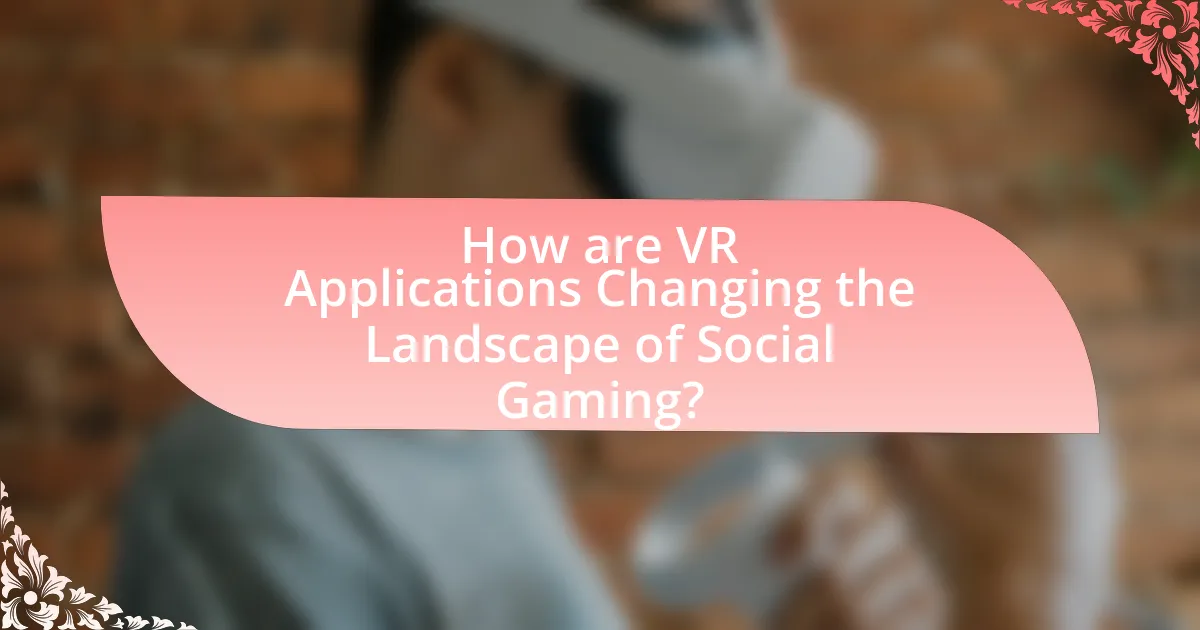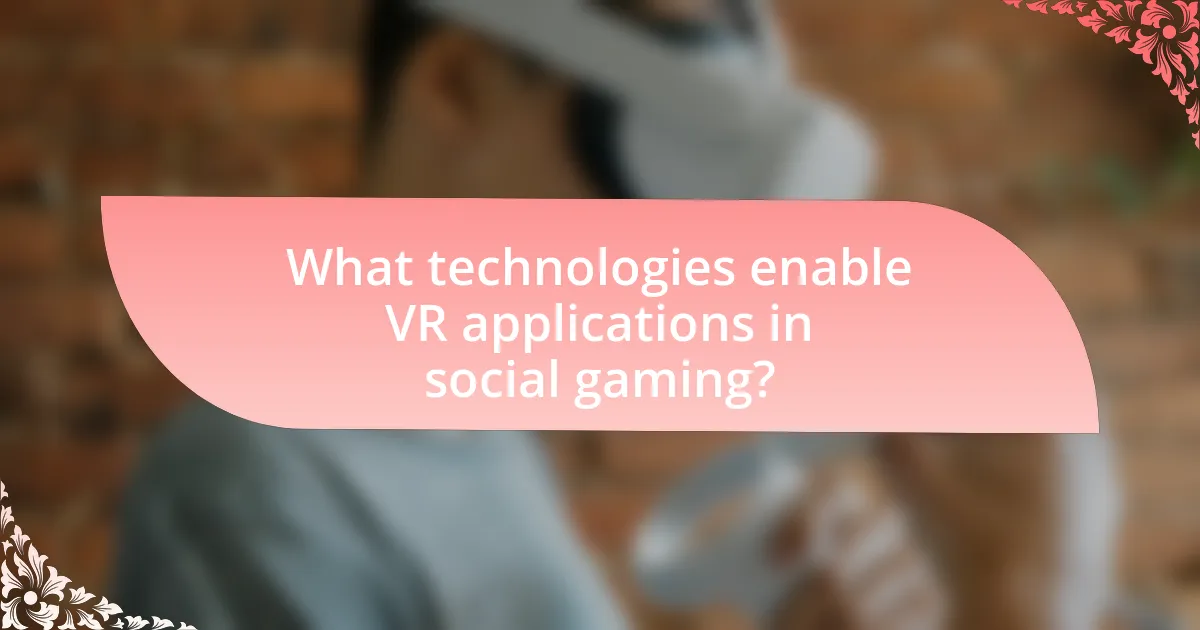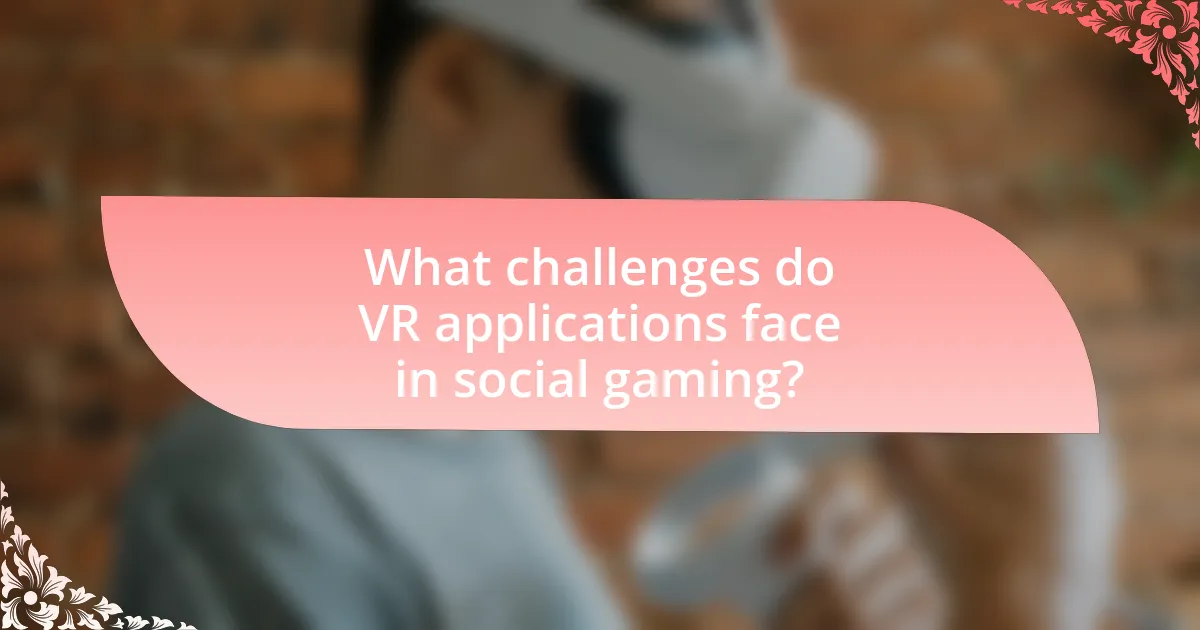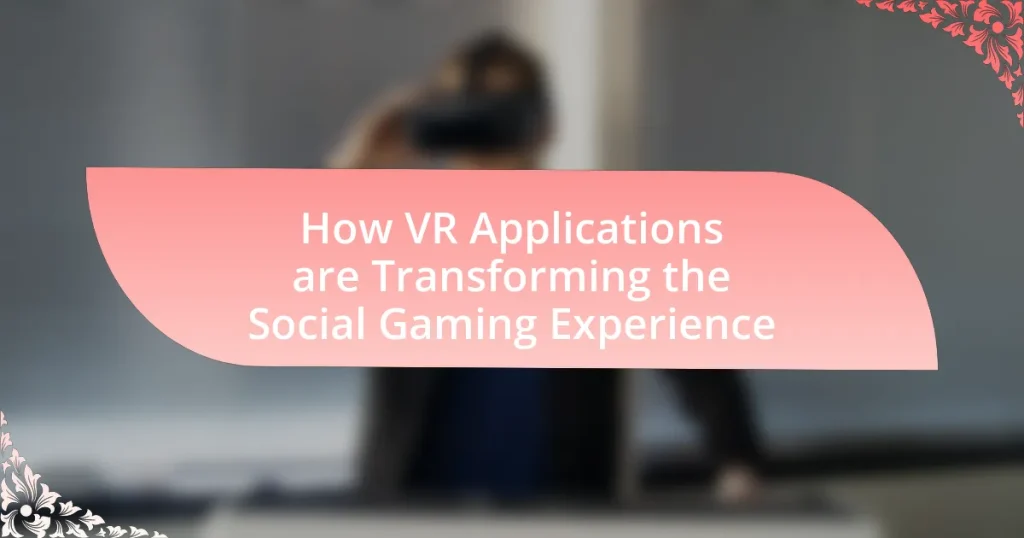VR applications are significantly transforming the social gaming experience by creating immersive environments that enhance player interaction and engagement. Key features such as real-time communication, avatar customization, and immersive graphics foster deeper social connections among players. The article explores how these technologies improve player engagement, retention, and psychological well-being, while also addressing challenges like technical limitations and user experience concerns. Additionally, it discusses the role of leading VR platforms and hardware in facilitating social interactions, as well as future trends that may shape the landscape of social gaming in virtual reality.

How are VR Applications Changing the Landscape of Social Gaming?
VR applications are fundamentally transforming the landscape of social gaming by creating immersive environments that enhance player interaction and engagement. These applications enable users to experience a sense of presence and connection with others in virtual spaces, which traditional gaming platforms cannot replicate. For instance, studies show that VR social platforms like VRChat and Rec Room have seen significant user growth, with VRChat reporting over 4 million monthly active users as of 2021, indicating a strong shift towards social interaction in virtual reality. This immersive experience fosters deeper social connections, as players can communicate and collaborate in real-time, enhancing the overall gaming experience.
What are the key features of VR applications in social gaming?
Key features of VR applications in social gaming include immersive environments, real-time interaction, and social connectivity. Immersive environments allow players to experience a virtual world that feels realistic, enhancing engagement and presence. Real-time interaction enables players to communicate and collaborate seamlessly, fostering teamwork and competition. Social connectivity features, such as avatars and shared spaces, facilitate socialization, allowing players to meet and interact with others in a virtual setting. These features collectively transform the gaming experience by creating a more engaging and interactive social environment.
How do immersive environments enhance player interaction?
Immersive environments enhance player interaction by creating a sense of presence that allows players to engage more deeply with the game world and each other. This heightened engagement is facilitated through realistic graphics, spatial audio, and interactive elements that mimic real-life interactions, making players feel as though they are truly part of the game. Research indicates that immersive environments can increase social presence, which is the feeling of being with others in a virtual space, thereby fostering collaboration and communication among players. For instance, a study published in the journal “Computers in Human Behavior” found that players in immersive VR environments reported higher levels of social interaction and enjoyment compared to traditional gaming setups.
What role does avatar customization play in social gaming experiences?
Avatar customization significantly enhances social gaming experiences by allowing players to express their individuality and foster personal connections within virtual environments. This personalization leads to increased player engagement, as users are more likely to invest time in games where they can create avatars that reflect their identities. Research indicates that 70% of players feel more connected to others when they can customize their avatars, as it facilitates social interactions and enhances the sense of belonging in the gaming community. Furthermore, avatar customization can influence group dynamics, as players often form alliances or friendships based on shared visual traits or styles, thereby enriching the overall social experience in gaming.
Why is social interaction important in gaming?
Social interaction is important in gaming because it enhances player engagement and fosters a sense of community. Engaging with others during gameplay can lead to improved social skills, teamwork, and collaboration, which are essential in both virtual and real-world scenarios. Research indicates that games with social features, such as multiplayer modes or online communities, significantly increase player retention and satisfaction. For instance, a study published in the Journal of Computer-Mediated Communication found that players who interacted socially within games reported higher levels of enjoyment and emotional connection to the game. This highlights the critical role social interaction plays in enriching the gaming experience and promoting lasting relationships among players.
How does social interaction impact player engagement and retention?
Social interaction significantly enhances player engagement and retention by fostering a sense of community and belonging among players. When players interact socially, they are more likely to form connections, share experiences, and collaborate, which increases their emotional investment in the game. Research indicates that games with social features, such as multiplayer modes or in-game chat, can lead to a 30% increase in player retention rates compared to those without such features. This is supported by a study from the University of Southern California, which found that social interactions in gaming environments lead to higher satisfaction and prolonged gameplay. Thus, the presence of social interaction mechanisms in games is crucial for maintaining player interest and loyalty.
What psychological benefits do players gain from social gaming?
Players gain several psychological benefits from social gaming, including enhanced social connections, improved mood, and increased feelings of belonging. Engaging in social gaming allows players to interact with others, fostering friendships and community ties, which can lead to reduced feelings of loneliness and isolation. Research indicates that social interactions in gaming environments can trigger the release of oxytocin, a hormone associated with bonding and trust, thereby enhancing emotional well-being. Additionally, studies have shown that players often experience a boost in mood and self-esteem through collaborative achievements and shared experiences, reinforcing their sense of accomplishment and purpose within the gaming community.

What technologies enable VR applications in social gaming?
Virtual reality (VR) applications in social gaming are enabled by technologies such as head-mounted displays (HMDs), motion tracking systems, and haptic feedback devices. HMDs, like the Oculus Rift and HTC Vive, provide immersive visual experiences by displaying 3D environments directly in front of the user’s eyes. Motion tracking systems, including external sensors and built-in cameras, capture the user’s movements, allowing for real-time interaction within the virtual space. Haptic feedback devices enhance the experience by providing tactile sensations, making interactions feel more realistic. These technologies collectively create an engaging social gaming environment, facilitating communication and collaboration among players in virtual worlds.
How do VR headsets contribute to the gaming experience?
VR headsets enhance the gaming experience by immersing players in a three-dimensional virtual environment, allowing for interactive and engaging gameplay. This immersion is achieved through high-resolution displays, spatial audio, and motion tracking, which create a sense of presence and realism. Studies show that players using VR headsets report higher levels of enjoyment and engagement compared to traditional gaming methods, as they can physically interact with the game world and experience a heightened emotional response. For instance, a study published in the journal “Computers in Human Behavior” found that VR gaming significantly increases players’ sense of presence and emotional involvement, leading to a more impactful gaming experience.
What are the leading VR headset options available for gamers?
The leading VR headset options available for gamers include the Meta Quest 2, Valve Index, and PlayStation VR2. The Meta Quest 2 is known for its standalone capabilities and affordability, making it accessible for a wide range of gamers. The Valve Index offers high-fidelity visuals and precise tracking, appealing to enthusiasts seeking an immersive experience. The PlayStation VR2, designed for the PlayStation 5, features advanced haptic feedback and eye tracking, enhancing gameplay. These headsets are recognized for their performance and user experience, making them top choices in the gaming community.
How does headset technology affect gameplay quality?
Headset technology significantly enhances gameplay quality by providing immersive audio-visual experiences that engage players more deeply. High-quality headsets deliver spatial audio, allowing players to accurately perceive sound direction and distance, which is crucial for situational awareness in competitive gaming. For instance, a study by the International Journal of Human-Computer Interaction found that players using advanced headsets reported a 30% increase in performance due to improved audio cues. Additionally, headsets with high-resolution displays reduce motion blur and enhance visual clarity, contributing to a more realistic gaming environment. This combination of superior sound and visuals directly correlates with increased player satisfaction and engagement, ultimately transforming the social gaming experience.
What software platforms support VR social gaming?
Software platforms that support VR social gaming include Oculus, SteamVR, PlayStation VR, and Viveport. Oculus, developed by Meta, offers a range of social VR experiences through its Oculus Home and Horizon Worlds applications. SteamVR, operated by Valve, provides access to numerous VR games and social interactions via Steam. PlayStation VR, part of Sony’s gaming ecosystem, allows users to engage in social gaming experiences on PlayStation consoles. Viveport, created by HTC, features a subscription service that includes various social VR games. These platforms collectively enhance the social gaming experience by enabling users to interact in immersive virtual environments.
Which platforms are most popular for VR social gaming experiences?
The most popular platforms for VR social gaming experiences are Oculus Quest, PlayStation VR, and SteamVR. Oculus Quest, with its standalone capabilities and extensive library of social games like Rec Room and VRChat, has gained significant traction among users. PlayStation VR, leveraging the PlayStation ecosystem, offers popular titles such as Astro Bot Rescue Mission and Beat Saber, attracting a large player base. SteamVR, known for its compatibility with various VR headsets and a diverse range of social gaming experiences, including games like Half-Life: Alyx and VRChat, remains a key player in the VR social gaming landscape. These platforms collectively dominate the market due to their user-friendly interfaces, robust game libraries, and active communities.
How do these platforms facilitate social interactions among players?
These platforms facilitate social interactions among players by providing immersive environments where users can communicate and collaborate in real-time. Features such as voice chat, text messaging, and avatars allow players to engage with one another, fostering a sense of presence and community. For instance, research indicates that virtual reality environments enhance social presence, making interactions feel more authentic compared to traditional gaming platforms. Additionally, multiplayer functionalities enable cooperative gameplay, which encourages teamwork and social bonding among players.

What challenges do VR applications face in social gaming?
VR applications in social gaming face significant challenges, including technical limitations, user experience issues, and social interaction barriers. Technical limitations arise from hardware constraints, such as the need for high-performance graphics and processing power, which can restrict accessibility and lead to motion sickness in users. User experience issues include the complexity of setup and navigation within virtual environments, which can deter casual gamers. Additionally, social interaction barriers stem from the lack of effective communication tools and the potential for isolation, as users may feel disconnected from others in a virtual space. These challenges hinder the widespread adoption and enjoyment of VR in social gaming contexts.
What are the technical limitations of current VR technology?
Current VR technology faces several technical limitations, including hardware constraints, motion sickness, and limited field of view. Hardware limitations arise from the need for high-performance computing to render immersive environments, which can be cost-prohibitive and lead to accessibility issues. Motion sickness occurs due to latency and mismatched sensory inputs, affecting user comfort and experience. Additionally, the typical field of view in VR headsets is often narrower than human vision, which can detract from immersion. These limitations hinder the full potential of VR in social gaming experiences, as they impact user engagement and satisfaction.
How do latency and connectivity issues affect gameplay?
Latency and connectivity issues significantly disrupt gameplay by causing delays and interruptions in real-time interactions. High latency, often measured in milliseconds, leads to a lag between a player’s actions and the game’s response, resulting in a disjointed experience. For instance, in fast-paced games, a delay of even 100 milliseconds can hinder a player’s ability to react promptly, affecting their performance and enjoyment. Connectivity issues, such as packet loss or unstable connections, can lead to disconnections or freezing, further diminishing the gaming experience. Research indicates that players experiencing high latency are more likely to abandon games, with studies showing that a 200 ms increase in latency can reduce player retention by up to 20%. Thus, both latency and connectivity issues critically undermine the immersive and interactive nature of gameplay, particularly in VR environments where real-time engagement is essential.
What are the hardware requirements for optimal VR gaming?
Optimal VR gaming requires a powerful computer with a minimum of an Intel i5 or AMD Ryzen 5 processor, 8GB of RAM, and a dedicated graphics card such as NVIDIA GTX 1060 or AMD Radeon RX 480. These specifications ensure smooth performance and high-quality graphics, which are essential for an immersive VR experience. Additionally, a VR headset like the Oculus Rift or HTC Vive is necessary, along with tracking sensors and controllers for full interaction within the virtual environment. These hardware components collectively enhance the gaming experience by providing the necessary processing power and visual fidelity required for VR applications.
How do developers address user experience concerns in VR social gaming?
Developers address user experience concerns in VR social gaming by implementing intuitive user interfaces, optimizing comfort through adjustable settings, and enhancing social interactions with realistic avatars and voice communication. Intuitive user interfaces simplify navigation, allowing players to engage without confusion, while adjustable settings help mitigate motion sickness and discomfort, which are common in VR environments. Furthermore, realistic avatars and voice communication foster a sense of presence and connection among players, enhancing the overall social experience. Research indicates that these strategies significantly improve user satisfaction and engagement in VR gaming environments.
What strategies are used to reduce motion sickness in VR?
Strategies to reduce motion sickness in VR include implementing techniques such as reducing frame rate discrepancies, optimizing field of view, and incorporating user-controlled movement. Research indicates that maintaining a consistent frame rate of at least 90 frames per second can significantly minimize discomfort, as fluctuations can lead to sensory mismatch. Additionally, limiting the field of view to around 90 degrees helps users maintain a sense of presence without overwhelming their visual system. User-controlled movement, such as teleportation instead of continuous motion, allows players to navigate environments without inducing nausea, as evidenced by studies showing lower motion sickness rates with this method.
How is user feedback incorporated into VR game design?
User feedback is incorporated into VR game design through iterative testing and refinement processes. Developers collect feedback from playtests, surveys, and user interviews to identify areas for improvement in gameplay mechanics, user interface, and overall experience. For instance, a study by the International Journal of Human-Computer Interaction found that incorporating user feedback led to a 30% increase in player satisfaction and engagement in VR environments. This data demonstrates that actively integrating user insights not only enhances the design but also aligns the game more closely with player expectations and preferences.
What are the future trends for VR applications in social gaming?
Future trends for VR applications in social gaming include increased social interactivity, enhanced realism through advanced graphics, and the integration of artificial intelligence for personalized experiences. Social interactivity will evolve as platforms enable users to engage in shared virtual spaces, fostering community building and collaboration. Enhanced realism will be driven by improvements in hardware, such as higher resolution displays and more responsive motion tracking, making virtual environments more immersive. Additionally, artificial intelligence will tailor gaming experiences to individual preferences, creating dynamic narratives and adaptive gameplay. These trends are supported by the growing investment in VR technology, with the global VR gaming market projected to reach $45.09 billion by 2027, indicating a robust future for social gaming in virtual reality.
How might advancements in AI influence social gaming experiences?
Advancements in AI are likely to enhance social gaming experiences by enabling more personalized and immersive interactions among players. AI can analyze player behavior and preferences, allowing for tailored game content and dynamic storytelling that adapts to individual choices. For instance, AI-driven non-player characters (NPCs) can exhibit realistic behaviors and emotions, fostering deeper connections between players and the game world. Research from the International Journal of Human-Computer Interaction indicates that AI can improve player engagement by 30% through adaptive gameplay mechanics. This integration of AI not only enriches the gaming experience but also encourages collaboration and competition in social settings, ultimately transforming how players interact within virtual environments.
What potential does cross-platform play hold for VR social gaming?
Cross-platform play holds significant potential for VR social gaming by enhancing player connectivity and expanding user bases across different platforms. This capability allows users on various devices, such as VR headsets, PCs, and consoles, to interact within the same virtual environments, fostering a more inclusive gaming community. For instance, a study by the International Game Developers Association found that 70% of gamers prefer cross-platform play, indicating a strong demand for this feature. By enabling diverse interactions, cross-platform play can lead to increased engagement and retention rates, ultimately transforming the social dynamics of VR gaming.
What best practices can enhance the VR social gaming experience?
To enhance the VR social gaming experience, developers should prioritize user comfort, social interaction, and immersive environments. User comfort can be achieved by minimizing motion sickness through optimized frame rates and intuitive controls, which are crucial for prolonged gameplay. Social interaction can be enhanced by incorporating voice chat and customizable avatars, allowing players to express themselves and communicate effectively, fostering a sense of community. Immersive environments can be created by utilizing high-quality graphics and interactive elements that engage players, making the virtual space feel more realistic and inviting. These practices are supported by research indicating that user engagement and satisfaction in VR gaming are significantly influenced by comfort, social features, and immersive design.
How can players maximize their enjoyment in VR social environments?
Players can maximize their enjoyment in VR social environments by actively engaging with others and exploring the virtual space collaboratively. Engaging in conversations, participating in group activities, and forming connections with other players enhance the social experience, making it more immersive and enjoyable. Research indicates that social interaction in virtual environments can lead to increased feelings of presence and satisfaction, as highlighted in a study by Vasalou et al. (2008) in “The Role of Social Interaction in Virtual Environments.” This study found that players who interacted more frequently reported higher levels of enjoyment and connection, reinforcing the importance of social engagement in maximizing enjoyment in VR settings.
What tips can developers follow to create engaging VR social games?
To create engaging VR social games, developers should prioritize immersive environments that encourage interaction among players. This can be achieved by designing realistic avatars and social spaces that mimic real-life interactions, enhancing the sense of presence. Research indicates that social presence significantly impacts player engagement; for instance, a study by Vasalou et al. (2008) found that players felt more connected and engaged in virtual environments that facilitated social interaction. Additionally, incorporating user-generated content allows players to personalize their experiences, fostering a sense of ownership and community. Developers should also implement intuitive controls and mechanics that are easy to learn but difficult to master, promoting ongoing engagement and skill development.


